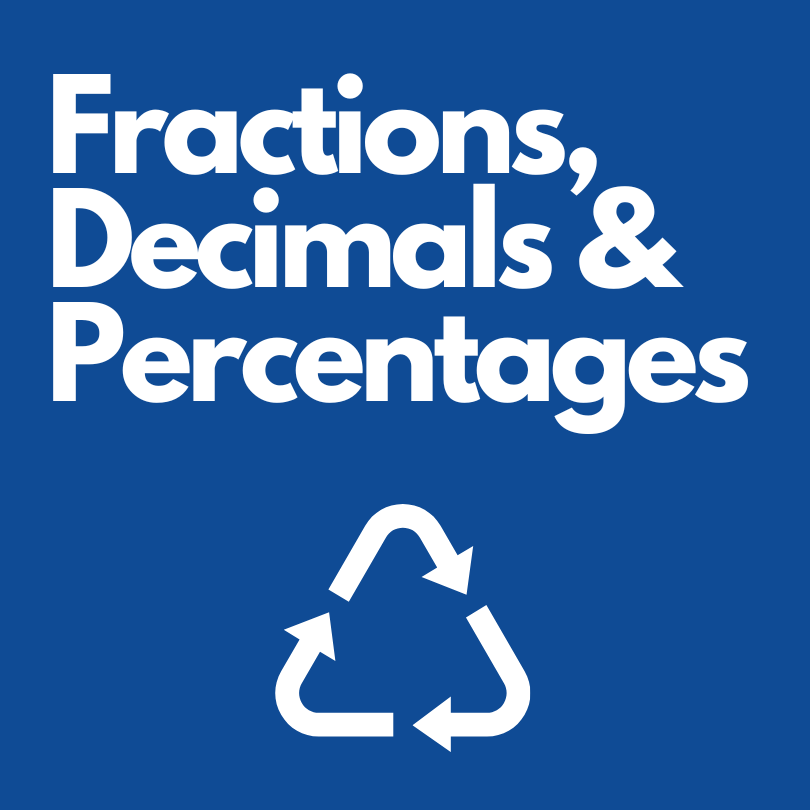Percent to Fraction Calculator
Convert a percentage value to a fraction
Fractions, Decimals & Percentages: Percent to Fractions
See all maths calculators
Percent to Fraction Conversion Guide
The Percent to Fraction Converter is a valuable tool that allows you to transform percentage values into their equivalent fraction representations. This comprehensive guide will walk you through the process of using such a converter, explain the concepts behind percent-to-fraction conversion, provide practical examples, and offer insights into common pitfalls and real-world applications.
Understanding Percentages and Fractions
Before diving into the conversion process, let's clarify some key concepts:
Percentages
A percentage is a way of expressing a number as a part of 100. It is denoted by the symbol %. For example, 50% means 50 out of 100, or half of a whole.
Fractions
A fraction represents a part of a whole. It consists of a numerator (top number) and a denominator (bottom number). For example, in the fraction 3/4, 3 is the numerator and 4 is the denominator.
Converting Percentages to Fractions
The process of converting a percentage to a fraction involves three main steps:
- Write the percentage as a fraction over 100.
- Simplify the fraction if possible.
- If the numerator is larger than the denominator, convert to a mixed number if desired.
For example, to convert 75% to a fraction:
- 75% = 75/100
- Simplify by dividing both numerator and denominator by their greatest common divisor (25):
75/100 = (75 ÷ 25) / (100 ÷ 25) = 3/4
Examples of Percent to Fraction Conversions
Let's look at a table of examples:
| Percentage | Conversion Process | Fraction Result |
|---|---|---|
| 100% | 100/100 = 1/1 | 1 |
| 50% | 50/100 = 1/2 | 1/2 |
| 25% | 25/100 = 1/4 | 1/4 |
| 75% | 75/100 = 3/4 | 3/4 |
| 20% | 20/100 = 1/5 | 1/5 |
| 33.33% | 33.33/100 ≈ 1/3 | 1/3 (approx.) |
| 150% | 150/100 = 3/2 | 1 1/2 |
| 0.5% | 0.5/100 = 1/200 | 1/200 |
Common Mistakes to Avoid
When using a Percent to Fraction Converter, be aware of these common pitfalls:
-
Forgetting to simplify: Always check if your fraction can be reduced to its simplest form.
-
Rounding errors: Be cautious with percentages that don't convert to exact fractions (like 33.33%).
-
Mishandling percentages over 100%: Remember that percentages over 100% convert to improper fractions or mixed numbers.
-
Confusion with decimals: Don't confuse the decimal form of a percentage with its fractional form.
-
Ignoring the context: In some contexts, it might be more appropriate to leave the fraction as an improper fraction rather than converting to a mixed number.
Practical Applications
Understanding how to convert percentages to fractions has numerous real-world applications:
Cooking and Baking
Recipe measurements often involve both percentages and fractions.
Example: If a recipe calls for 75% whole wheat flour, you know you need 3/4 whole wheat flour and 1/4 white flour.
Finance and Investing
Some financial concepts are easier to understand as fractions rather than percentages.
Example: A 50% return on investment is the same as saying your investment grew by a factor of 1/2.
Academic Grading
Grade calculations often involve converting percentages to fractions.
Example: If a student scores 80% on a test, this could be expressed as 4/5 of the total possible points.
Construction and Carpentry
Measurements in construction often involve both percentages and fractions.
Example: If a roof has a 25% slope, this is equivalent to a 1/4 rise over run.
Real World Analogies (RWA)
To better understand percent to fraction conversions, consider these real-world analogies:
-
Pizza Slices:
- 50% of a pizza is 1/2 of the pizza.
- 25% of a pizza is 1/4, or one standard slice of a pizza cut into 4 pieces.
- 75% of a pizza is 3/4, or three slices of a four-slice pizza.
-
Time:
- 25% of an hour is 1/4 of an hour, or 15 minutes.
- 50% of a day is 1/2 of a day, or 12 hours.
- 33.33% of a week is approximately 1/3 of a week, or about 2 days and 8 hours.
-
Sports:
- If a basketball player makes 50% of their free throws, they're making 1/2 of their attempts.
- If a baseball player has a .250 batting average, they're hitting successfully in 1/4 of their at-bats.
-
Sales and Discounts:
- A 20% discount is equivalent to 1/5 off the original price.
- If an item is marked up by 50%, its new price is 3/2 (or 1 1/2) times the original price.
These real-world analogies help to ground abstract percent-to-fraction conversions in concrete, everyday situations, making them easier to understand and remember.
Using Technology: Percent to Fraction Converters
While it's important to understand the manual process, Percent to Fraction Converters can quickly perform conversions, especially for complex percentages. When using such converters:
- Verify the input format required by the converter (e.g., whether to include the % symbol).
- Double-check your entries for accuracy.
- Understand the output format provided by the converter (improper fraction, mixed number, or both).
- Use the results judiciously, especially in professional or academic contexts where showing your work may be required.
The Importance of Understanding Percent to Fraction Conversions
Converting percentages to fractions is a fundamental skill that extends beyond simple arithmetic. It's crucial for many fields including cooking, finance, academics, and construction. By mastering these conversions, you enhance your numerical literacy and problem-solving skills.
Conclusion
Using a Percent to Fraction Converter to change percentage values into their equivalent fraction representations is a valuable skill that enhances your ability to work with numerical data. Whether you're a student, a professional, or simply someone who enjoys working with numbers, understanding this process can improve your mathematical capabilities and practical problem-solving skills.
Remember, while converters are powerful tools, understanding the underlying concepts is crucial. Practice manual conversions alongside using the converter to develop a deep understanding of the relationship between percentages and fractions.
Key Takeaways
- Understand that a percentage is a way of expressing a number as a part of 100.
- To convert a percentage to a fraction, write it over 100 and then simplify.
- Be aware of common mistakes such as forgetting to simplify or mishandling percentages over 100%.
- Recognize the practical applications in cooking, finance, academics, and construction.
- Use real-world analogies to better understand and remember percent-to-fraction conversions.
- While converters are helpful, understanding the manual process is crucial for developing mathematical intuition.
- Remember that some percentages (like 33.33%) convert to approximate fractions, while others (like 75%) convert to exact fractions.
By mastering percent to fraction conversions, you'll have a powerful tool at your disposal for understanding and working with numerical data in various real-world scenarios.

